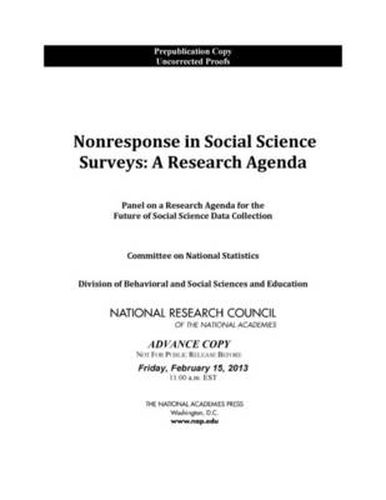Readings Newsletter
Become a Readings Member to make your shopping experience even easier.
Sign in or sign up for free!
You’re not far away from qualifying for FREE standard shipping within Australia
You’ve qualified for FREE standard shipping within Australia
The cart is loading…






For many household surveys in the United States, responses rates have been steadily declining for at least the past two decades. A similar decline in survey response can be observed in all wealthy countries. Efforts to raise response rates have used such strategies as monetary incentives or repeated attempts to contact sample members and obtain completed interviews, but these strategies increase the costs of surveys. This review addresses the core issues regarding survey nonresponse. It considers why response rates are declining and what that means for the accuracy of survey results. These trends are of particular concern for the social science community, which is heavily invested in obtaining information from household surveys. The evidence to date makes it apparent that current trends in nonresponse, if not arrested, threaten to undermine the potential of household surveys to elicit information that assists in understanding social and economic issues. The trends also threaten to weaken the validity of inferences drawn from estimates based on those surveys. High nonresponse rates create the potential or risk for bias in estimates and affect survey design, data collection, estimation, and analysis.
The survey community is painfully aware of these trends and has responded aggressively to these threats. The interview modes employed by surveys in the public and private sectors have proliferated as new technologies and methods have emerged and matured. To the traditional trio of mail, telephone, and face-to-face surveys have been added interactive voice response (IVR), audio computer-assisted self-interviewing (ACASI), web surveys, and a number of hybrid methods. Similarly, a growing research agenda has emerged in the past decade or so focused on seeking solutions to various aspects of the problem of survey nonresponse; the potential solutions that have been considered range from better training and deployment of interviewers to more use of incentives, better use of the information collected in the data collection, and increased use of auxiliary information from other sources in survey design and data collection. Nonresponse in Social Science Surveys: A Research Agenda also documents the increased use of information collected in the survey process in nonresponse adjustment.
$9.00 standard shipping within Australia
FREE standard shipping within Australia for orders over $100.00
Express & International shipping calculated at checkout
For many household surveys in the United States, responses rates have been steadily declining for at least the past two decades. A similar decline in survey response can be observed in all wealthy countries. Efforts to raise response rates have used such strategies as monetary incentives or repeated attempts to contact sample members and obtain completed interviews, but these strategies increase the costs of surveys. This review addresses the core issues regarding survey nonresponse. It considers why response rates are declining and what that means for the accuracy of survey results. These trends are of particular concern for the social science community, which is heavily invested in obtaining information from household surveys. The evidence to date makes it apparent that current trends in nonresponse, if not arrested, threaten to undermine the potential of household surveys to elicit information that assists in understanding social and economic issues. The trends also threaten to weaken the validity of inferences drawn from estimates based on those surveys. High nonresponse rates create the potential or risk for bias in estimates and affect survey design, data collection, estimation, and analysis.
The survey community is painfully aware of these trends and has responded aggressively to these threats. The interview modes employed by surveys in the public and private sectors have proliferated as new technologies and methods have emerged and matured. To the traditional trio of mail, telephone, and face-to-face surveys have been added interactive voice response (IVR), audio computer-assisted self-interviewing (ACASI), web surveys, and a number of hybrid methods. Similarly, a growing research agenda has emerged in the past decade or so focused on seeking solutions to various aspects of the problem of survey nonresponse; the potential solutions that have been considered range from better training and deployment of interviewers to more use of incentives, better use of the information collected in the data collection, and increased use of auxiliary information from other sources in survey design and data collection. Nonresponse in Social Science Surveys: A Research Agenda also documents the increased use of information collected in the survey process in nonresponse adjustment.